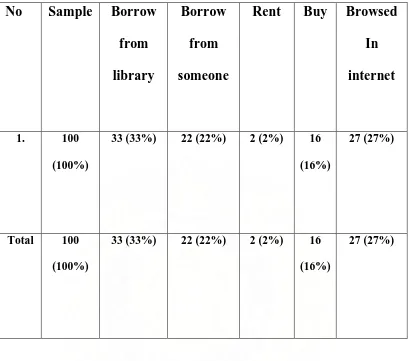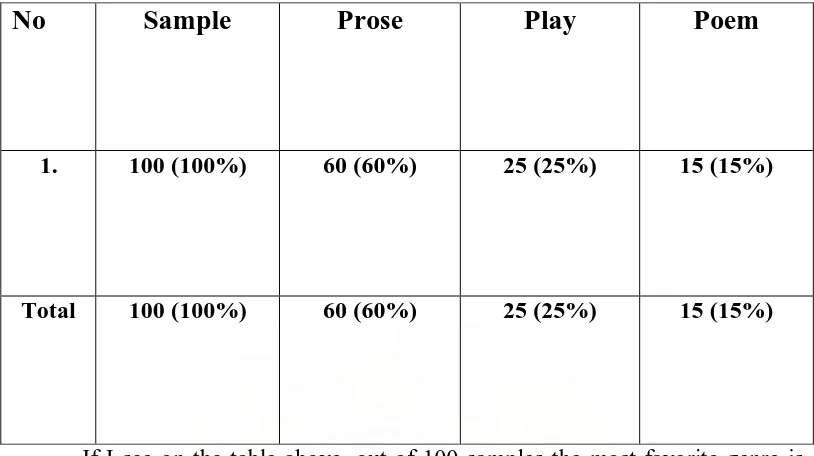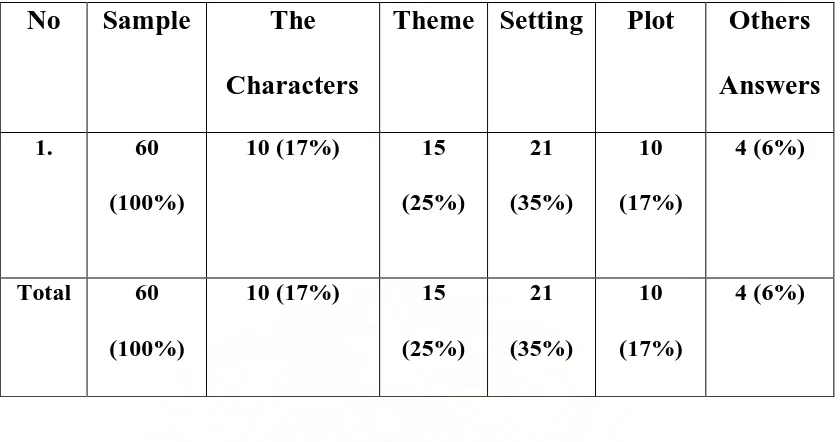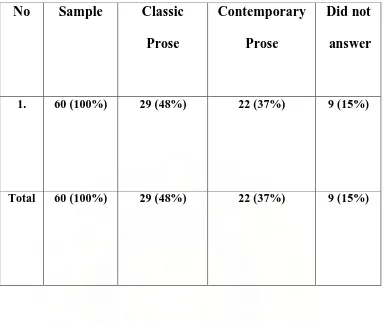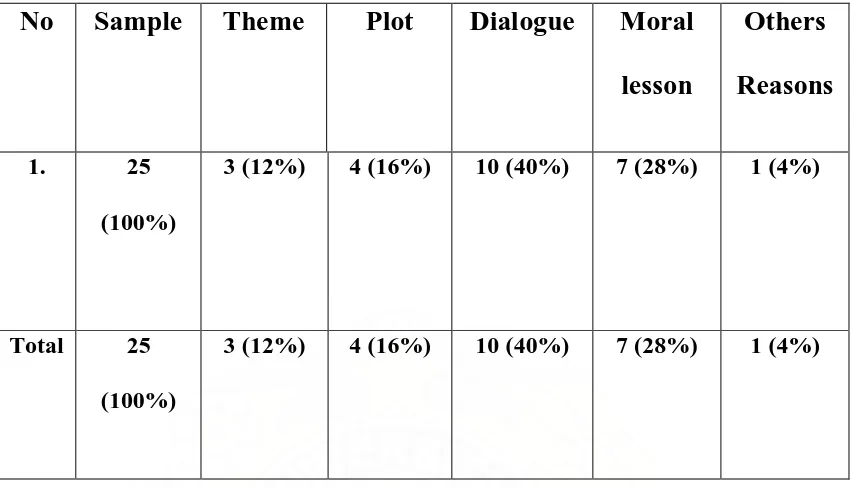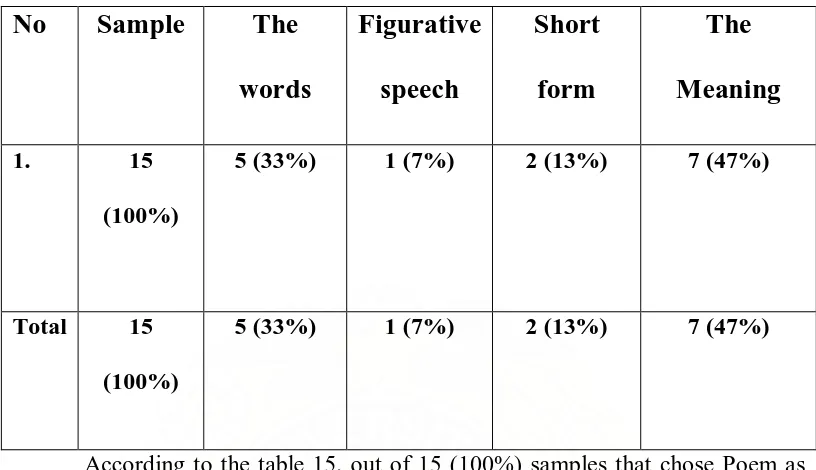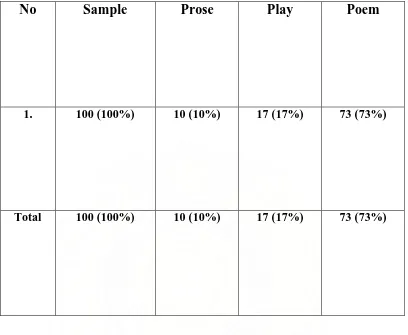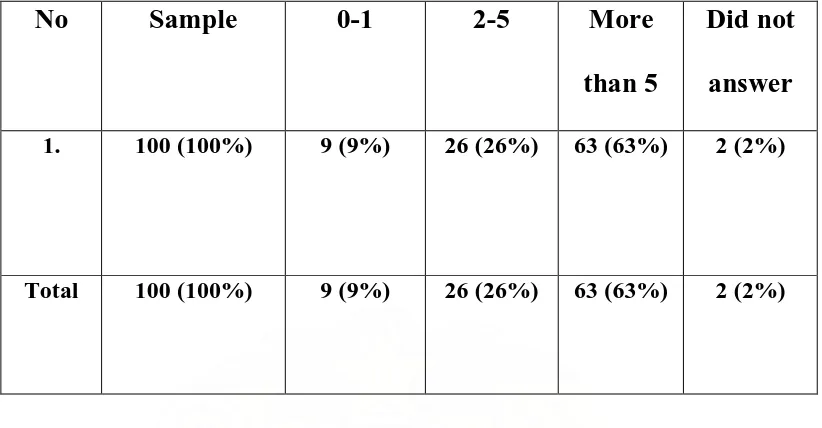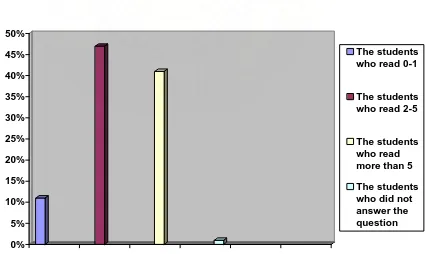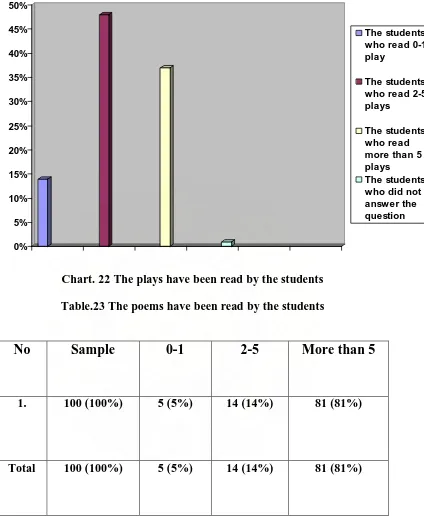THE INTEREST OF ENGLISH STUDENTS OF
FACULTY OF LETTERS, IN THE UNIVERSITY
OF SUMATERA UTARA IN READING
LITERARY WORKS
A THESIS
BY
SHERA Z HUTABARAT
REG. NO 050705030
ENGLISH LITERATURE DEPARTMENT
FACULTY OF LETTERS
UNIVERSITY OF SUMATERA UTARA
ACKNOWLEDGEMENT
First, I would like to praise and give Heavenly Father the Almighty God in
the name of Jesus Christ the greatest honour who always gives me His blessings,
guidance and spirit to finish this thesis.
The thesis is about a research deals with the interest of English Students of
Faculty of Letters, in the University of Sumatera Utara in reading literary works.
I would like to say thank to some lecturers who helped and guided to write
this thesis, they are:
1. Prof. Syaiffudin, M.A, Ph.D as the Dean of Faculty of Letters in
University of Sumatera Utara.
2. Dra. Swesana M Lubis, M.Hum as the Head of English Literature
Department in University of Sumatera Utara.
3. Drs. Yulianus Harefa, M.Ed TESOL as the Secretary of English
Literature Department in University of Sumatera Utara.
4. Dra. Martha Pardede, M.S as my Supervisor and Dra. Syahyar Hanum,
DPFE as my Co-Supervisor for the precious advices, supporting
assistance and understanding that motivated me to finish this thesis.
5. Drs. M. Syafiei Siregar, M.A as my Academic Supervisor for the
encouragement during my study at English Literature Department in
I also thank all of my brothers and sisters in my lovely small group,
“Praise the Lord”: Timbul, Ivan, Monalisa, and Mariana Fe who always support
me with their love, care, pray and attention. Thank you for everything that we
have shared through all these years. May God Bless you all!
I also thank all my sisters in “Famz in Christ”: Anna, Ayaki, Eva, Evy,
Herlina, Liana and Yulietha who always remind and support me to finish this
thesis.
I will never forget to thank my incredible loving, supportive, and great
family, my Father Z. Hutabarat and my lovely Mother A. Sembiring, I dedicate
this thesis to them. Special thank them that had struggled, tried to full fill all of
my needs and prayed for me all the time. Moreover, I thank my sweetest sisters
Nesya, Ria and Karina for their loving, caring, and kindness that encourage me to
finish this thesis. I will always love you all forever more.
Finally yet importantly, I would like to say thank to my best friend Yoland
who always supports me and to my entire friends for their participation to help me
to do and finish this thesis; Anne, Pinkx, Eve, Emmy, Poe2, Henny, Swarnie, Sri
Handayani, Asna, Dinda, Irene, and whose names cannot be put in this thesis.
They will be in my heart. Thank a lot for everything that they have done for me.
Finally, I hope this thesis will always be beneficial for the readers.
ABSTRAK
Skripsi ini berjudu l The Interest of English Department Students in
Faculty of Letters in University of Sumatera Utara In Reading Literary Works
TABLE OF CONTENTS
ACKNOWLEDGEMENTS ... i
ABSTRACT ... ii
TABLE OF CONTENTS ... iii
CHAPTER I INTRODUCTION ... 1
1.1Background of Research ... 1
1.2Statement of Problems ... 4
1.3Objectives of Research ... 4
1.4Significance of Research ... 5
1.5Scope of Research ... 5
CHAPTER II THEORITICAL REVIEW ... 6
2.1 Literature and Society ... 6
2.2 Literary Sociology ... 9
CHAPTER III METHOD OF RESEARCH ... 11
3.1 Method of Research ... 11
3.2 Population and Sample ... 11
CHAPTER IV DATA ANALYSIS ... 13
CHAPTER V CONCLUSIONS AND SUGGESTIONS ... 105
5.1 Conclusions ... 105
5.2 Suggestions ... 106
BIBLIOGRAPHY ... 107
CHAPTER I
INTRODUCTION
1.1 Background of Research
The term of literature and sociology are two fields of knowledge that
cannot be separated from each other. Literature and Sociology are two studies that
are different from each other but they have close relation. Sociology derives from
the Greek ‘ Socius’ (society) and ‘logos’ (science) which means the study of all
the aspects of human and their relation in community (Ratha, 2003:1). Literature
derives from Latin ‘littera’ which primarily refers to the written or printed words
(Kasim, 2005:1). The relationship between literature and society is usually
discussed by starting with the phrase, derived from De Bonald, that ‘literature is
an expression of society’ (Wellek, 1963:95). Some relations between Literature
and Society are: literary works absolutely is the part of society and it uses
language which is the part of social institution, literary works is for the readers
who are the members of society, and literary works is a picture of society.
Literature is a social institution, using as its medium language, a social
creation (Wellek, 1963:94). As the social institution, the term of literature and
literary works cannot be separated from people. Ironically, on the view of Taufik
Ismail
of them read the non-fiction books. In 2006, the research showed that only 23, 5%
gained the information from reading. The rest of them preferred watching TV and
listening radio to collect information. This result shows how Indonesian people do
not rely much on reading to get information, reading is not yet a habit for them.
To respond this, Primanto Nugroho
(http://kalipaksi.wordpress.com/2007/06/23/sastra-pelajar-minat-baca-dan-taufik-ismail/) commented that reading is an activity which requires much time.
Ironically, many of them spend more time to work and earn money. Consequently
they have less time to read. Moreover, the books cost are quite expensive, so
many of them cannot afford to buy (Nurhidayah, 2007).
In this thesis, I am going to find out some conditions that happen around
the English Department students as the part of a society about their attitude toward
reading literary works and the factors that influence them in reading literary
works. The interest of English Department students to read English literary works
has a big beneficial because they have to know much about it by having many
references so that they can learn it well.
In English Department, the students study English literature works.
Besides, they also learn and practice in speaking, listening, writing, and reading.
English Department is chosen by many Senior High Schools students because
they want to increase their ability in English. They usually think that their English
skills can be improved in English Department. In fact, the students that have
In English Department, literary works are the object that must be studied
by the students. One of the aims of this Department is to teach the students how to
analyze the literary works. English Department in University of Sumatera Utara
offers two kinds of concentrate mainly linguistics and literature. Linguistics deals
with morphology, semantic, syntax, phonology, and pragmatic. Whereas literary
deals with prose, play, and poetry.
Reading is one of the important things to support the study, especially for
English Department students who have to study literary works. All literary works
have messages for the readers such as moral lessons. So, the students have to able
to comprehend its meaning to get the messages. Besides, they learn the style, the
beauty of language, the history and the social condition that happened when the
literary works were created. By analyzing the literary works, they also can add
their knowledge, enrich vocabularies, and teach the students to think critically.
That is the reason why I want to do a research to find out the interest of
English Department students in University of Sumatera Utara in reading literary
works and the factors that influence them to read literary works.
1.2 Statement of Problems
The students who take literature are less than the students who take
linguistics. For example, the class of 2004 only has 10 students and the class of
2005 also only 8 students who took the literature. Therefore, linguistics is taken
skill in speaking English. Basically, the students of Faculty of Letters are
supposed to know and understand many literary works. Because one of the aims
of this Faculty is to teach the students to be able to analyze literary works.
To find out the facts about the interest of English Department students in
reading literary works, there are some questions that need to be explained. The
questions can be formulated as follow:
1. How is the interest of English Department students in Faculty of Letters
University of Sumatera Utara in reading literary works?
2. What are the factors that influence the students to read literary works?
1.3 Objectives of Research
The objective of the research tends to answer the problem of research.
Based on the problems above, the purpose of this research mainly:
1. To identify the interest of English Department students in reading literary
works.
2. To find out the factors that influences the students to read literary works.
1.4 Scope of Research
There are some ways to prove that literary works and society have close
connection. In this thesis I limit the scope of the research only on the students of
English Department students in University of Sumatera Utara as my
correspondence to identify the member of students who are interested in reading
I limit the scope of the research only to know the interest of English
Department students in reading literary works. I do not analyze about the ability
or the ways of students in analyzing the literary works.
1.5 Significance of Research
It is expected that this study will be beneficial for those who are interested
to take literature as their major. Thus some significance expected to reach are as
follows:
1. The readers will get more and more the explanation about factors that
influence the students to be interested in reading literary works.
2. The readers will get some information about the beneficial of learning
literary works.
3. This thesis would be enriching the literary study and it can be used as
source of information for the readers especially students of literature
who are interested in this kind of research.
1.6 Review of Related Literature
I found a journal which I used as sources in finding the data and
information to analyze this thesis. This journal as the main source, in finding the
data and information to analyze this thesis, is
Raswief, Dra. Nilzami dan Dra. Roswita Silalahi. (1993) in their research
Laporan Penelitian Minat Membaca Karya Sastra Inggris Dari Mahasiswa Jurusan Sastra Inggris Fakultas Sastra Universitas Sumatra Utara Medan, the
CHAPTER II
THEORITICAL REVIEW
2.1Literature and Society
The term ‘literature’ has been widely defined by many people and experts,
but some of the definitions have one common sense, that is literature is a creative
work produced by imagination. Klarer (2004:1) says that in most cases, literature
is refers to as the entirety of written expression, with the restriction that not every
document can be categorized as literature in the more exact sense of the word. The
definition, therefore, usually include additional adjectives such as “aesthetic” or
“artistic” to distinguish literary work from texts of everyday use as telephone
books, newspaper, legal documents, and scholarly writings. Literature is a creative
writing by an author with aesthetic values, which makes literature regarded as an
art. Literature as a writing from differentiates it from the other art products, and its
aesthetic or artistic values make it different from other writings.
The word ‘Literature’ is derives from Latin ‘littera’ that primarily refers to
the written or printed words (Kasim, 2005:1). Literature refers to compositions
that tell stories, dramatic situation, expresses emotions, an analysis, and advocates
ideas.
So many definitions of literature; Literature is the
Literally translated, the word means "acquaintance with letters" (from
phras
types include
Literature is the collective body of literary productions, embracing the
entire results of knowledge and fancy preserved in writing; also, the whole body
of literary productions or writings upon a given subject, or in reference to a
particular science or branch of knowledge, or of a given country or period; as, the
literature of Biblical criticism; the literature of chemistry.
Literature is the class of writings distinguished for beauty of style or
expression, as poetry, essays, in history, in diction from scientific treaties and
works, whichcontain positive knowledge.
Literature, a body of written works related by subject matter (e.g. the
literature of computing), by language or place of origin (e.g. Russian literature), or
by prevailing cultural standards of merit. In this last sense, ‘literature’ is taken to
include oral, dramatic, and broadcast compositions that may not have been
published in written form but which have been (or deserve to be) preserved. Since
the 19th century, the broader sense of literature as a totality of written or printed
works has given way to more exclusive definitions based on criteria of
imaginative, creative, or artistic value, usually related to a work's absence of
factual or practical reference. Even more restrictive has been the academic
natural world and the inner or subjective world of the individual have also been
objects of literary imitation. Based on the definition above, Literature has relation
with social reality or society.
Literature and Society has close relation to each other because, the relation
between literature and society is usually discussed by starting with the phrase,
derived from De Bonald, and that ‘literature is an expression of society’ (Wellek,
1963:95). Some relations between Literature and Society are; literary works
absolutely is the part of society and use language as the part of social institution,
literary works is for the reader as the members of society, and literary works is a
picture of society.
A society, then, is a group of people with a shared and somewhat distinct
culture, who live in a defined territory, feel some unity as a group, and see
themselves as distinct from other peoples. A society needs to be independent
enough to avoid being swallowed up by other societies (Persell, Caroline Hodger.
1987). The word society may also refer to an
people for religious, benevolent, cultural, scientific, political, patriotic, or other
purposes. The English word "society" emerged in the 15th century and is derives
from the French société. The French word, in turn, had its origin in the
"companion, associate, and comrade or business partner." The Latin word is
probably related to the verb sequi, "to follow", and thus originally may have
meant "follower". (www.wikipedia.com)
single Human societies are characterized by patterns of relationships between individuals that share a distinctive groups, a society allows its individual members to achieve individual needs or wishes that they could not fulfill separately by themselves, without the existence of the social group. Society, however, may be unique in that it is qualities of its constituent individuals. As a reality its own kind", it is hinder rather than help the pursuits of the physical and psychological underpinnings.
A society, in short, is relative independent collection of people who share
a common heritage and common ways of interacting.” (Persell, Caroline Hodger.
1987)
Literary Sociology
Literature and Sociology are two studies that are different from each other,
but they have relation. Sociology derives from the Greek ‘ Socius’ (society) and
‘logos’ (science) which means the study of all the aspect of human and their
relation in community (Ratha, 2003:1). Literary Sociology is a branch of literary
study that examines the relationships between literary works and their social
contexts, including patterns of literacy, kinds of audience, modes of publication
and dramatic presentation, and the social class positions of authors and readers.
Lanson proposed the idea of "literary sociology," a complex formulation
between. The text was a composite work on which society exerted powerful and
unseen forces but that could still escape those forces in order to present something
outside of them: perhaps a hope or fantasy of something better.
Sociology is an objective and scientific studies about human in society;
studies about social institution and social process. Same as sociology, Literature is
also studies about the relation between the human in society, the human’s effort
for adapting with the society and change the institution (Damono, 1979: 7-8). The
different between them is, Sociology deals with a scientific and objective analysis
but Literature shows the ways of life of human among society, their feeling
through society with literary works.
Literary sociology is a study of literary works by paying attention to the
social aspects (Ratna, 2003:2). In literary sociology, there are three classifications
about the scope.
First, the writer’s social context; this part talked about the writer’s social
position in society and their relation to the readers. In this scope is also explained
about social factors that influence the writers like, the writer’s occupation, writer’s
professionalism, and the readers of their works. Second, literature as the mirror of
society; how far the literary works describe the situation in society. Third, social
function of literature which explain how far a literary works can be related to
social condition and how far literature values are influenced by social condition.
CHAPTER III
METHODOLOGY
3.1 Research Method
Field research is used in collecting the data. The method of the study that
used is quantitative method. Quantitative method is a method of analyzing data by
choosing the population and sample and using questioner to collect the data
(Suyanto 2005: 135).
The research has conducted at English Department in Faculty of Letters in
University of Sumatera Utara with the students from three batches 2005, 2006,
and 2007 as the samples.
3.2 Population and Sample
Webster (2003:966) states that a population is group of individual persons,
objects, or items from which samples are taken for measurement while a sample is
a finite part of statistical population whose properties are studied to gain
information about the whole.
The population of this research is 100 students from English Department
in Faculty of Letters. Those students become the respondents who took the
questionnaires. The members of question for data are 50 questions. From the total
Simple Random Sampling involves the identifying procedure on every
element in the sampling frame and choosing them based on any planned process
that also ensures that every element has an equal opportunity of being selected.
When sampling frames are too large for slips of paper in a hat or some similar
procedure, a random number table can be used (Dane 1990: 297)
3.3 Data Collecting Method
In collecting the data, some steps that are used mainly:
1. Choosing the population and sample for the research randomly.
2. Giving questioners to the sample.
3. Collecting questioners from the sample.
3.4 Data Analysis Method
The data are analyzed by examining the answer that have made by English
Department Students in University of Sumatera Utara by using Bungin’s Theory
(2005:172)
The formula is n = x100%
N fx
.
n = Percentages of the answers
CHAPTER IV
DATA ANALYSIS
Table.1 Condition based on the gender
No
Batch
Sample
Female
Male
1.
2.
3.
2005
2006
2007
44 (44%)
37 (37%)
19 (19%)
31 (31%)
23 (23%)
16 (16%)
13 (13%)
14 (14%)
3 (3%)
Total 100 (100%) 70 (70%) 30 (30%)
From the data above, I can see that the most samples are women. It proves
that in English Department the most dominant students are women. The
percentages of women are 70% in other hand the percentage of man are 30%. In
2005’ from 44% samples, the percentages of women are 31% and the men are
13%. In 2006’ from 37% samples, the percentages of women are 23% and the
0% 5% 10% 15% 20% 25% 30% 35%
Women
Men
2005
2006
2007
Chart.1 Condition based on the gender
Table.2 Condition based on the interest in reading literary works in Senior
High School
No
Sample
Interested
Not Interested
1. 100 (100%) 58 (58%) 42 (42%)
If I see the table, the percentages of English students in University of
Sumatera Utara out of 100 samples who were interested in reading literary works
were in Senior High School are 58% and 42% are not interested in reading literary
works when they were in Senior High School. See the chart below.
0% 10% 20% 30% 40% 50% 60%
Interested
Are not
interested
Table.3 English Department as the first choice
No
Sample
First Choice
Others Choice
1. 100 (100%) 56 (56%) 44 (44%)
Total 100 (100%) 56 (56%) 44 (44%)
Based on the table above, it can be seen that out of 100 samples, the
students who has chose English Department as their first choice are 56% and 44%
students did not choose English Department as their first choice. See the chart
0% 10% 20% 30% 40% 50% 60%
English
Department as First Choice English
Department as others choices
Chart. 3 English Department as the first choice Table.4 English Department as others choice
No
Sample
Second choice
Third choice
1. 44 (100%) 36 (82%) 8 (18%)
If I see the table, out of 44 samples, the students who has chose English
Department as their Second Choice are 36 (82%) and the students who has chose
it as their third choice are 8 (18%). See the chart below.
0% 10% 20% 30% 40% 50% 60% 70% 80% 90%
Students who has chose English Department as their Second choice Students who has chose English Department as their Third choice
Chart .4 English Department as another choice Table.5 The Reasons to study in English Department
No
Sample
Study about
language
Study about
literature
Did not
answer
1. 100 (100%) 82 (82%) 15 (15%) 3 (3%)
If I see the table 5, out of 100 samples, 82 (82%) the students chose
English Department because they wanted to study about the language and only 15
(15%) students wanted to study about Literature, and 3 (3%) did not answer the
question.
From this table I know that almost all of the students chose English
Department because they wanted to study about Language than to study about
literature. See the chart below.
0% 10% 20% 30% 40% 50% 60% 70% 80% 90%
Study about language
Study about literature
students who did not answer the question
Table.6 The reasons for reading literary works
No
Sample
Like reading
Have to read
1. 100 (100%) 43 (43%) 57 (57%)
Total 100 (100%) 43 (43%) 57 (57%)
Based on the table above, out of 100 samples the students who like reading
literary works as their reason to read literary works is 43 (43%) and the rest of
them 57 (57%) read literary works because they have to read.
Based on the table I can see, it is so ironically that more than 50 % student
in English Department read literary works because they have to read the literary
0%
10%
20%
30%
40%
50%
60%
The students who like reading The students who have to read
Chart.6 The reasons for reading literary works Table.7 The reasons for enjoying reading literary works
No Sample Interesting Add knowledge
Enrich
vocabularies
All Others
reasons
1. 43 (100%)
12 (28%) 7 (16%) 9 (21%) 14 (33%)
1 (2%)
Total 43
(100%)
12 (28%) 7 (16%) 9 (21%) 14 (33%)
According to the table above, out of 43 samples I can see some reasons
why the students enjoying reading literary works, there are: 12 (28%) like reading
literary works, because it is interesting, 7 (16%) like reading literary works
because it is add knowledge, 9 (21%) like reading literary works because it is
enrich vocabularies. In addition, 14 (33%) like reading because it is interesting,
add knowledge, and enrich vocabularies, and 1 (2%) enjoying reading literary
works because they are interested to the story. See the chart below.
0% 5% 10% 15% 20% 25% 30% 35%
The students who are interested in reading literary works
The students who can add their knowledge by reading literary works The students who can enrich their vocabularies by reading literary works The students who chose all answer
The students who gave others reasons
Table.8 The reasons for reading literary works as obligatory task
No
Sample
Boring
Difficult
All
Others
reasons
1. 57 (100%) 17 (30%) 26 (46%) 7 (12%) 7 (12%)
Total 57 (100%) 17 (30%) 26 (46%) 7 (12%) 7 (12%)
From the table 8, I can see there are two reasons why the students in
English Department read literary works; first, they like reading and the second one
because they have to read it. They have to read literary works it is means they do
not like reading literary works.
There are some reasons why the students said they do not like it; 17 (30%)
answered that reading literary works is a boring activity, 26 (46%) said that it is
difficult for them to read literary works. More over 7 (12%) do not like it because
reading literary works is a boring activity and it is difficult for them, 7 (12%) gave
others reasons like reading is wasting time and they must do their assignments.
0% 5% 10% 15% 20% 25% 30% 35% 40% 45% 50%
The students who felt boring
The student who think it is difficult
The students who have chose all answer The students who give others reasons
Table.9 The ways to get Literary works
No
Sample
Borrow
from
library
Borrow
from
someone
Rent
Buy
Browsed
In
internet
1. 100 (100%)
33 (33%) 22 (22%) 2 (2%) 16 (16%)
27 (27%)
Total 100 (100%)
33 (33%) 22 (22%) 2 (2%) 16 (16%)
27 (27%)
Based on the table, out of 100 samples, the students get literary works with
some ways, there are; 33 (33%) borrowing from the library, 22 (22%) borrowing
from someone, 2 (2%) renting the literary works, 16 (16%) buying and 27 (27%)
browsed in internet.
I can see that most of the students 33 (33%), borrowing from the library as
their alternative to get literary works. The other ways to get literary works is by
0% 5% 10% 15% 20% 25% 30% 35%
The students who borrow from library The students who borrow from someone else
The students who rent them
The students who buy them
The students who browsed in internet
Table.10 The favorite genre
No
Sample
Prose
Play
Poem
1. 100 (100%) 60 (60%) 25 (25%) 15 (15%)
Total 100 (100%) 60 (60%) 25 (25%) 15 (15%)
If I see on the table above, out of 100 samples the most favorite genre is
prose 60 (60%), and followed by play 25 (25%) and next to it is poem 15 (15%).
See the chart below.
0% 10% 20% 30% 40% 50% 60%
Table.11 The reasons for choosing prose works as the favorite genre
No
Sample
The
Characters
Theme Setting
Plot
Others
Answers
1. 60
(100%)
10 (17%) 15
(25%)
21
(35%)
10
(17%)
4 (6%)
Total 60
(100%)
10 (17%) 15
(25%)
21
(35%)
10
(17%)
4 (6%)
Based on the table 11, 60 samples chose Prose as their favorite genre.
There are some reasons why they chose it as their favorite genre; they like the
characters 10 (17%), they like the theme 15 (25%), they interesting with the place
and culture 21 (35%). They like the plot of the story 10 (17%) and some students
4 (6%) gave others reasons they like prose because the story is dynamic and
unique.
In addition, the most favorite reason why they chose prose are they likes
0% 5% 10% 15% 20% 25% 30% 35% 40%
The students who like the characters The students who like the theme The students who like the setting The students who like the plot
The students who gave others answers
Table.12 The favorite prose works
No
Sample
Classic
Prose
Contemporary
Prose
Did not
answer
1. 60 (100%) 29 (48%) 22 (37%) 9 (15%)
Total 60 (100%) 29 (48%) 22 (37%) 9 (15%)
Based on the table above, out of 60 samples who like prose, 29 (48%)
chose classic prose as their favorite prose. Some classic prose that they like are:
‘Animal Farm’, ‘The Old Man and The Sea’, ‘Jane Austen’, ‘Sillas Manner’, ‘Scarlet letter’, A Tale of Two Cities’, ‘Pride and Prejudice’, ‘Oliver Twist’ and ‘Lady Chatterley’s Lovers’. Meanwhile 22 (37%) chose contemporary prose as
their favorite. Some Contemporary prose, which they like, are: ‘Twilight’, ‘Harry
Potter’, ‘The Da Vinci Code’, ‘The Kite Runner’, ‘The Trilogy of Lord of The Rings’, ‘The Broken Wings’, ‘Jacky Faber’, ‘A Rose for Emily’, ‘Trilogy of Indiana’, and ‘Life on the Refrigerator’s Door’. And 9 (15%) did not answer the
0% 5% 10% 15% 20% 25% 30% 35% 40% 45% 50%
The students who like classic prose
The students who like contemporer prose
The students who did not answer the question
Table.13 The reasons for choosing play as the favorite genre
No
Sample
Theme
Plot
Dialogue
Moral
lesson
Others
Reasons
1. 25
(100%)
3 (12%) 4 (16%) 10 (40%) 7 (28%) 1 (4%)
Total 25
(100%)
3 (12%) 4 (16%) 10 (40%) 7 (28%) 1 (4%)
Based on the table 13, out of 25 samples who chose Play as their favorite
genre there are some reasons why they chose it as their favorite genre: because
they like the Theme 3 (12%), they like the Plot 4 (16%), they interesting with
Dialogue 10 (40%). They like the Moral lesson 7 (28%) and 1 (4%) gave others
reasons because they like act. In addition, the most favorite reason why they chose
0% 5% 10% 15% 20% 25% 30% 35% 40% 45%
The students who like the theme
The students who like the plot
The students who like the dialogue
The students who like the moral lesson in the play
The students who gave another reasons
Table.14 The favorite play
No
Sample The Death
of
Salesman
Romeo
and
Juliet
A Doll’s
House
Others
Plays
Did not
answer
1. 25 (100%) 3 (12%) 7 (28%) 2 (8%) 5 (20%) 8 (32%)
Total 25 (100%) 3 (12%) 7 (28%) 2 (8%) 5 (20%) 8 (32%)
Based on the table above, out of 25 (100%) samples who like play, some
play that they like are ‘The Death of Salesman’ 3 (12%), ‘Romeo and Juliet’ 7
(28%), and ‘A Doll’s House’ 2 (8%). Others plays 5 (20%), which they like, are
‘The Merchant of Venice’,’ a Street Car Named Desire’,’ Riders to the Sea’,
‘Macbeth’ and ‘Mid Summer Night’s Dream’. Moreover, 8 (32%) did not answer
0% 5% 10% 15% 20% 25% 30% 35%
The students who like 'The Death of Salesman' The students who like ' Romeo and Juliet' The students who like 'A Doll's House'
The students who chose others plays The students who did not answer the question
Table.15 The reason for choosing poem as the favorite genre
No
Sample
The
words
Figurative
speech
Short
form
The
Meaning
1. 15
(100%)
5 (33%) 1 (7%) 2 (13%) 7 (47%)
Total 15
(100%)
5 (33%) 1 (7%) 2 (13%) 7 (47%)
According to the table 15, out of 15 (100%) samples that chose Poem as
their favorite genre there are some reasons why they chose it as their favorite
genre; because they like the words 5 (33%), they like the figurative speech 1
(7%), they like the short form 2 (13%). They like the Meaning 7 (47%).
In addition, the most favorite reason why they chose prose is they like the
0% 5% 10% 15% 20% 25% 30% 35% 40% 45% 50%
The students who like the words The students who like the figurative speech The students who like the short form The students who like the meaning
Table.16 The favorite poem
No
Sample
I’m
Nobody
Who are
You
Catherine’s
Dreams
Red
Rose
Others
Poems
Did
not
answer
1. 15
(100%)
2 (13%) 3 (20%) 2
(13%)
6 (40%) 2 (13%)
Total 15
(100%)
2 (13%) 3 (20%) 2
(13%)
6 (40%) 2 (13%)
Based on the table above, out of 15 (100%) samples who like poem, some
poem that they like are I’m Nobody who are You 2 (13%), ‘Catherine’s Dreams’ 3
(20%), and ‘Red Rose’ 2 (13%). Others poems 6 (40%), which they like, are
‘Democracy’, ‘The Road not Taken’, ‘The wild Rose’, ‘The Craned Wall’, ‘Stopping by Woods on A Snowy Evening’, and ‘Fire and Ice’ . Moreover, 2
0% 5% 10% 15% 20% 25% 30% 35% 40% 45%
The students who like 'I'm no Body Who are You' The students who like ' Catherine's Dreams' The students who like 'Red Rose'
The students who like others poems The students who did not answer the question
Table.17 The favorite theme
No Sample Romantic Heroic Religious Feministic Others
answers
Did not
answers
1. 100
(100%)
62 (62%) 22
(22%)
5 (5%) 4 (4%) 3 (3%) 4 (4%)
Total 100
(100%)
62 (62%) 22
(22%)
5 (5%) 4 (4%) 3 (3%) 4 (4%)
According to the table 17, the theme most liked by most of students is
romantic 62 (62%), followed by 22 (22%) like heroic theme, 5 (5%) like religious
theme, and 4 (4%) like feminism theme, 3 (3%) like others themes like mystery,
struggle of life, science, etc. Moreover 4 (4%) did not answer the question. See
0% 10% 20% 30% 40% 50% 60% 70%
The students who like
Romantic theme The students who like Heroic theme
The students who like
Religious theme The students who like
Feministic theme The students who like others themes
The students who like more than 1 themes The students who did not answer the question
Table.18 The favorite text to read
No
Sample
Read original text
Read simplified
1. 100 (100%) 31 (31%) 69 (69%)
Total 100 (100%) 31 (31%) 69 (69%)
From the table above, I can conclude that the students prefer to read
literary works in simplified than to read it in the original text. Almost 70% of
students like reading literary works in simplified. Contrast with the students who
like reading the literary works in original text only 31% students like it. See the
0% 10% 20% 30% 40% 50% 60% 70%
The students who like to read the original text The students who like to read the simplified
Table.19 The hardest genre of literature
No
Sample
Prose
Play
Poem
1. 100 (100%) 10 (10%) 17 (17%) 73 (73%)
Total 100 (100%) 10 (10%) 17 (17%) 73 (73%)
According to the table above, out of 100 samples, most of the students
chose poem as the hardest genre of literature for them to understand. 73 (73%)
students chose poem as the hardest genre of literature for them to understand, 17
(17%) students chose play as the hardest genre of literature for them to understand
and 10 (10%) students chose prose as the hardest genre of literature for them to
0% 10% 20% 30% 40% 50% 60% 70% 80%
The students who chose prose
The students who chose play
The students who chose poem
Table.20 The short stories have been read by the students
No
Sample
0-1
2-5
More
than 5
Did not
answer
1. 100 (100%) 9 (9%) 26 (26%) 63 (63%) 2 (2%)
Total 100 (100%) 9 (9%) 26 (26%) 63 (63%) 2 (2%)
According to the table above, out of 100 samples, 63 (63%) students have
been read more than 5 short stories since they studied at English Department, 26
(26%) students have been read 2-5 short stories since they studied at English
Department and only 9 (9%) students have been read 0-1 short story since they
studied at English Department. In addition 2 (2%) did not answer the question.
0% 10% 20% 30% 40% 50% 60% 70%
The students who read 0-1 short story The students who read 2-5 short stories The students who read more than 5 short stories The students who did not answer the question
Table.21 The novels have been read by the students
No
Sample
0-1
2-5
More than 5
Did not
Answer
1. 100 (100%) 11 (11%) 47 (47%) 41 (41%) 1 (1%)
Total 100 (100%) 11 (11%) 47 (47%) 41 (41%) 1 (1%)
According to the table 21, out of 100 samples, 47 (47%) students have
been read 2-5 novels since they studied at English Department, 41 (41%) students
have been read more than 5 novels since they studied at English Department and
11 (11%) students have been read 0-1 novel since they studied at English
Department. Meanwhile 1 (1%) did not answer the question. See the chart below.
0% 5% 10% 15% 20% 25% 30% 35% 40% 45% 50% The students who read 0-1
The students who read 2-5
The students who read more than 5 The students who did not answer the question
Table.22 The plays have been read by the students
No
Sample
0-1
2-5
More than
5
Did not
answer
1. 100 (100%) 14 (14%) 48 (48%) 37 (37%) 1 (1%)
Total 100 (100%) 14 (14%) 48 (48%) 37 (37%) 1 (1%)
Based on the table 22, out of 100 samples, 48% students have been read
2-5 plays since they studied at English Department, 37% students have been read
more than 5 plays since they studied at English Department and 14% students
have been read 0-1 play since they studied at English Department and 1 (1%) did
0% 5% 10% 15% 20% 25% 30% 35% 40% 45% 50% The students who read 0-1 play
The students who read 2-5 plays
The students who read more than 5 plays
The students who did not answer the question
[image:56.595.119.543.101.630.2]Chart. 22 The plays have been read by the students
Table.23 The poems have been read by the students
No
Sample
0-1
2-5
More than 5
1. 100 (100%) 5 (5%) 14 (14%) 81 (81%)
Total 100 (100%) 5 (5%) 14 (14%) 81 (81%)
In table 23, out of 100 samples, 81 (81%) students have been read more
than 5 poems since they studied at English Department, 14 (14%) students have
students have been read 0-1 poem since they studied at English Department. See
the chart below.
0% 10% 20% 30% 40% 50% 60% 70% 80% 90%
The students who read 0-1 poem
The students who read 2-5 poems The students who read more than 5 poems
[image:57.595.126.551.157.476.2]Chart. 23 The poems have been read by the students
Table.24 The interest in reading others prose besides the works studied in
class
No
Sample
Yes
No
Did not
answer
1. 100 (100%) 58 (58%) 41 (41%) 1 (1%)
Based on the table above, I can conclude that out of 100 samples the
students who read others prose besides the prose in class are 58%, and 41% did
not read others prose besides the works that they study in class and 1 (1%) did not
answer the question. See the chart below.
0% 10% 20% 30% 40% 50% 60%
The students who read others prose besides the works studied in class The students who did not read others prose besides the works studied in class
The students who did not answer the question
Chart. 24 The interest in reading others prose besides the works studied in
Table.25 The number of prose works that the students have been read
besides the prose studied in class
No
Sample
0-1
2-5
More than 5
Did not
answer
1. 58 (100%) 5 (9%) 30 (52%) 22 (38%) 1 (2%)
Total 58 (100%) 5 (9%) 30 (52%) 22 (38%) 1 (2%)
According to the table above, out of 58 (100%) samples, I can see that 30
(52%) students have been read 2- 5 prose besides the prose they study in class, 22
(38%) students have been read more than 5 prose besides the prose they study in
class. Moreover, 5 (9%) students have been read 0-1 prose besides the prose they
0% 10% 20% 30% 40% 50% 60%
The students who read 0-1 prose besides the works studied in class The students who read 2-5 prose besides the works studied in class The students who did not answer the question
Chart. 25 The number of prose works that the students have been read
Table.26 The interest in reading others plays besides the works studied in
class
No
Sample
Yes
No
Did not
Answer
1. 100 (100%) 27 (27%) 72 (72%) 1 (1%)
Total 100 (100%) 27 (27%) 72 (72%) 1 (1%)
Based on the table 26, I can conclude that, out of 100 samples, only 27
(27%) students who read other plays besides the plays they study in class and 72
(72%) did not read others plays besides the works that they study in class.
0% 10% 20% 30% 40% 50% 60% 70% 80%
The students who read play besides the play studied in class The students who did not read play besides the play studied in class
The students who did not answer the question
Chart.26 The interest in reading others plays besides the works studied in
Table.27 The number of plays that the students have been read besides the
play studied in class
No
Sample
0-1
2-5
More than 5
1. 27 (100%) 4 (15%) 19 (70%) 4 (15%)
Total 27 (100%) 4 (15%) 19 (70%) 4 (15%)
Based on the table above, out of 27 (100%) samples, I can see that 19
(70%) students have been read 2- 5 plays besides the plays they study in class, 4
(15%) students have been read more than 5 plays besides the plays they study in
class. In addition, 4 (15%) students have been read 0-1 play besides the plays they
0% 10% 20% 30% 40% 50% 60% 70%
The students who read 0-1 plays besides the plays studied in class The students who read 2-5 plays besides the plays studied in class The students who read more than 5 plays besides the plays studied in class
Chart.27 The number of plays that the students have been read besides the
Table.28 The interest in reading others poems besides the works studied in
class
No
Sample
Yes
No
1. 53 (100%) 53 (53%) 47 (47%)
Total 53 (100%) 53 (53%) 47 (47%)
If I see the table above, I can conclude that, out of 100 samples, 53 (53%)
students read others poems besides the poems they study in class, and 47 (47%)
did not read others poems besides the works that they study in class. See the chart
44% 45% 46% 47% 48% 49% 50% 51% 52% 53%
The students who read others poems beside the poems studied in class
The students who did not read others poems beside the poems studied in class
Table.29 The number of poems that the students have been read besides the
poem studied in class
No
Sample
0-1
2-5
More than 5
1. 53 (100%) 6 (11%) 28 (53%) 19 (36%)
Total 53 (100%) 6 (11%) 28 (53%) 19 (36%)
Based on the table 29, out of 53 (100%) samples, I can see that 28 (53%)
students have been read 2- 5 poems besides the poems they get in class, 19 (36%)
students have been read more than 5 poems besides the poems they get in class. In
addition, 6 (11%) students have been read 0-1 poem besides the poems they get in
0% 10% 20% 30% 40% 50% 60%
The students who read 0-1 poem beside the poem studied in class The students who read 2-5 poem beside the poem studied in class The students who read more than 5 poem beside the poem studied in class
Chart. 29 The number of poems that the students have been read besides the
Table.30 The interest in reading obligatory novels
No
Sample
All
2 of them
Only 1
No
Did not
answer
1. 100 (100%) 44 (44%) 48 (48%) 5 (5%) 2 (2%) 1 (1%)
Total 100 (100%) 44 (44%) 48 (48%) 5 (5%) 2 (2%) 1 (1%)
From the table above, I can conclude that, out of 100 samples, 48 (48%)
students ever read two of the obligatory novels. 44 (44%) students have read all of
the novels, 5 (5%) students ever read one of the novels and 2 (2 %) never read the
0% 5% 10% 15% 20% 25% 30% 35% 40% 45% 50%
The students who interested in reading all of the novels that inquired
The students who interested in reading 2 of the novels that inquired
The students who interested in reading 1 of the novels that inquired
The students who are not interested in reading the novels that inquired
The students who did not answer the question
Table.31 The favorite novel studied in the class
No
Sample
The Old
man
And the
Sea
Sillas
Manner
Pride and
Prejudice
Did not
answer
1. 92
(100%)
46 (50%) 24 (26%) 21 (23%) 1 (1%)
Total 92
(100%)
46 (50%) 24 (26%) 21 (23%) 1 (1%)
Based on the table above, out of 92 (100%) samples, I can see that their
favorite novel is The Old Man and The Sea with 46 (50%). Followed by Sillas
Manner with 24 (26%) and Pride and Prejudice with 21 (23%). Meanwhile 1
0% 5% 10% 15% 20% 25% 30% 35% 40% 45% 50%
The students who chose 'The Old Man and the Sea'
The students who chose 'Sillas Manner'
The students who chose 'Pride and Prejudice'
The students who did not answer the question
Table.32 The reason for choosing the favorite novel
No Sample Characters Theme Setting Plot Others Answers
Did not answer
1. 92
(100%)
34 (37%) 31
(34%)
22
(24%) 1
(1%)
2 (2%) 2 (2%)
Total 92
(100%)
34 (37%) 31
(34%)
22
(24%) 1
(1%)
2 (2%) 2 (2%)
According to the table above, I can conclude that, out of 92 (100%)
samples, 34 (37%) students chose the novel because the characters in the novel
are interesting. 31 (34%) students chose it because the theme, 22 (24%) students
chose it because in the novel contains fascinating culture and place. 1 (1%) chose
it because the plot of the novel, 2 (2%) chose it because the morel lessons in the
0% 5% 10% 15% 20% 25% 30% 35% 40%
The students who like the characters The students who like the theme The students who like the setting The students who like the plot
The students that gave others answers
The students that did not answer the question
Table.33 The interest in reading obligatory poems
No
Sample
All
2 of them
Only 1
No
Did
not
answer
1. 100 (100%) 33 (33%) 41 (41%) 15 (15%) 10 (10%) 1 (1%)
Total 100 (100%) 33 (33%) 41 (41%) 15 (15%) 10 (10%) 1 (1%)
From the table 33, I can conclude that, out of 100 samples 41 (41%)
students ever read two of the obligatory poems. 33 (33%) students have read all of
the poems, 15 (15%) students ever read one of the poems, 10 (10%) never read the
0% 5% 10% 15% 20% 25% 30% 35% 40% 45%
The students who read all of the poems that inquired The students who read 2 of the poems that inquired
The students who read 1 of the poem that inquired The students who did not read the poem that inquired The students who did not answer the question
Table.34 The favorite poem studied in the class
No
Sample
The Road
Not Taken
I am No Body
Who are You
Fire
and Ice
Did not
answer
1. 74
(100%)
24 (32%) 41 (55%) 8 (11%) 1 (1%)
Total 74
(100%)
24 (32%) 41 (55%) 8 (11%) 1 (1%)
Based on the table above, out of 74 (100%) samples, I can see that their
favorite poem from the poems studied in the class is I am No Body Who are You
with 41 (55%), followed by The Road Not Taken with 24 (32%). Followed by
Fire and Ice with 8 (11%) and 1 (1%) did not answer the question. See the chart
0% 10% 20% 30% 40% 50% 60%
The students who like 'The Road Not Taken' The students who like 'I am No Body Who are You'
The students who like 'Fire and Ice' The students who did not answer the question
Table.35 The reason for choosing the favorite poem
No
Sample
The
words
Figurative
speech
Short
form
The
Meaning
Others
Answers
1. 74
(100%)
16 (22%) 10 (13%) 7 (9%) 39 (53%) 2 (3%)
Total 74
(100%)
16 (22%) 10 (13%) 7 (9%) 35 (53%) 2 (3%)
According to the table above, I can conclude that, out of 74 (100%)
samples, 35 (53%) students chose the poem because the meaning of the poem, 16
(22%) like the words in the poem. 10 (13%) like it because the poem has
figurative speech, 7 (9%) like the short form. 2 (3%) chose it because the moral
0% 10% 20% 30% 40% 50% 60%
The students who like the words The students who like the figurative speech The students who like the short form The students who like the meaning The students who gave others reasons
Table.36 The interest in reading obligatory plays
No
Sample
All
2 of them
Only 1
No
Did not
answer
1. 100 (100%) 20 (20%) 53 (53%) 22 (22%) 4 (4%) 1 (1%)
Total 100 (100%) 20 (20%) 53 (53%) 22 (22%) 4 (4%) 1 (1%)
From the table 36, out of 100 samples, I can conclude that, out of 100
(100%) samples, 53 (53%) students ever read two of the obligatory plays. 20
(20%) students have read all of the plays, 22 (22%) students ever read one of the
plays and 4 (4%) never read the plays. Meanwhile 1 (1%) did not answer. See the
0% 10% 20% 30% 40% 50% 60%
The students who read all of the plays that inquired The students who read 2 of the plays that inquired The students who read 1 of the plays that inquired The students who did not read the plays that inquired The students who did not answer the question
Table.37 The favorite play studied in the class
No
Sample A Streetcar
Named
Desire
Romeo
and Juliet
The Death of
Salesman
Did not
answer
1. 73
(100%)
16 (22%) 44 (60%) 12 (17%) 1 (1%)
Total 73
(100%)
16 (22%) 44 (60%) 12 (17%) 1 (1%)
Based on the table above, out of 73 (100%) samples, I can see that their
favorite play is Romeo and Juliet with 44 (60%). Followed by A Street Car
Named Desire with 16 (22%), The Death of Salesman with 12 (17%) and 1 (1%)
0% 10% 20% 30% 40% 50% 60%
The students who like ' A Streetcar Named Desire' The students who like ' Romeo and Juliet'
The students who like ' The Death of Salesman'
The students who did not answer the question
Table.38 The reason for choosing the favorite play
No
Sample
Theme
Plot
Dialogue
Moral
lessons
Others
answer
1. 73 (100%) 17 (23%) 14 (19%) 15 (21%) 24 (33%) 3 (4%)
Total 73 (100%) 17 (23%) 14 (19%) 15 (21%) 24 (33%) 3 (4%)
According to the table above, I can conclude that, out of 73 (100%)
samples, 24 (33%) students chose the play because the moral lesson in the play,
14 (19%) like the plot, 17 (23%) chose it because the theme. 15 (21%) chose it
because the dialogue of the play and 3 (4%) gave others reasons why they like that
play because the content of the play, the play ordered by the lecturer, etc. See the
0% 5% 10% 15% 20% 25% 30% 35%
The students who like the theme The students who like the Plot The students who like the dialogue The students who like the moral lesson
The students who gave others reasons
[image:86.595.125.551.103.341.2]Chart. 38 The reason for choosing the favorite play
Table.39 The interest in following the growth of literary works
No
Sample
Yes
No
1. 100 (100%) 28 (28%) 72 (72%)
Total 100 (100%) 28 (28%) 72 (72%)
Based on the table above, it shown that, out of 100 (100%) samples, only
28 (28%) students who are interested in following the growth of literary works,
and 72 (72%) students are not interested in following the growth of literary works.
0% 10% 20% 30% 40% 50% 60% 70% 80%
The Students who interested in following the growth of literary works
The Students who are not interested in following the growth of literary works
Chart. 39 The interest in following the growth of literary works Table.40 Special times prepared to read literary works
No
Sample
Yes
No
1. 100 (100%) 20 (20%) 80 (80%)
According to the table above, I can conclude that, out of 100 samples only
20 (20%) students who have special time to read literary works, but 80 (80%)
students do not have special time to read literary works. See the chart below.
0% 10% 20% 30% 40% 50% 60% 70% 80%
The students who have special time to read literary works The students who do not have special time to read literary works
[image:88.595.117.541.195.683.2]Chart. 40 Special times prepared to read literary works
Table.41 Literary works having read in a month
No
Sample
0-1
2-5
More than
5
Did not
answer
1. 100 (100%) 57 (57%) 36 (36%) 5 (5%) 2 (2%)
According to the table 41, out of 100 samples, I can conclude that, only 5
(5%) students who read literary works more than 5 works in a month, 36 (36%)
students read 2-5 literary works in a month, 57 (57%) read 0-1 literary works in a
month and 2 (2%) students did not answer the question. See the chart below.
0% 10% 20% 30% 40% 50% 60%
The students who read 0-1 literary works in a month
The students who read 2-5 literary works in a month
The students who read more than 5 literary works in a month
The students who did not answer the question
Table.42 The amount of money prepared to buy literary works
No
Sample
Yes
No
1. 100 (100%) 22 (22%) 78 (78%)
Total 100 (100%) 22 (22%) 78 (78%)
According to the table above, I can conclude that, out of 100 samples, only
22 (22%) students who have special budget to buy literary works, and 78 (78%)
0% 10% 20% 30% 40% 50% 60% 70% 80% The students who have special budget to buy literary works
The students who do not have special budget to buy literary works
[image:91.595.121.539.122.489.2]Chart. 42 The amount of money prepared to buy literary works
Table.43 The amount of money allocated to buy literary works
No
Sample
0 -
Rp.25.000
Rp.26.000
–
Rp.50.000
Rp.51.000
–
Rp.100.000
More
than
Rp.100.00
1. 100
(100%)
6 (6%) 6 (6%) 7 (7%) 3 (3%)
Total 100
(100%)
According to the table 43, out of 100 samples, I can conclude that, 6 (6%)
students who allocate 0 – Rp.25.000 to buy literary wor
